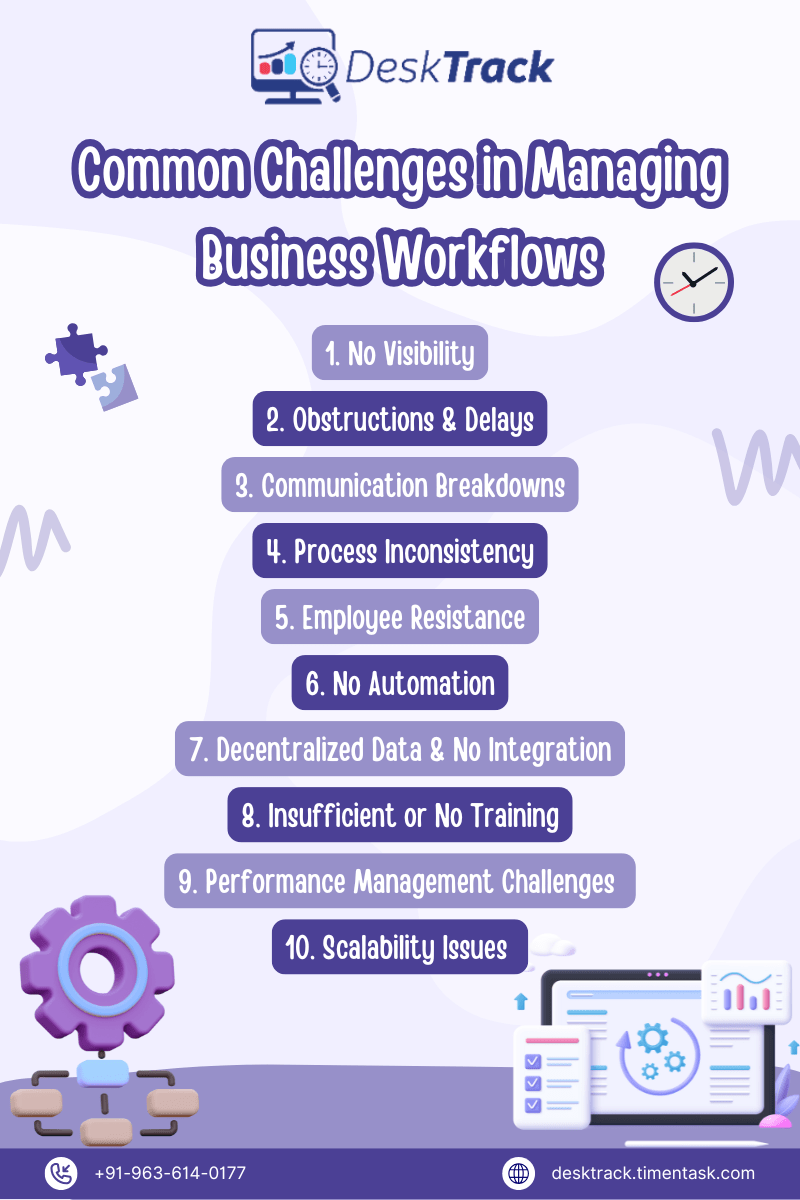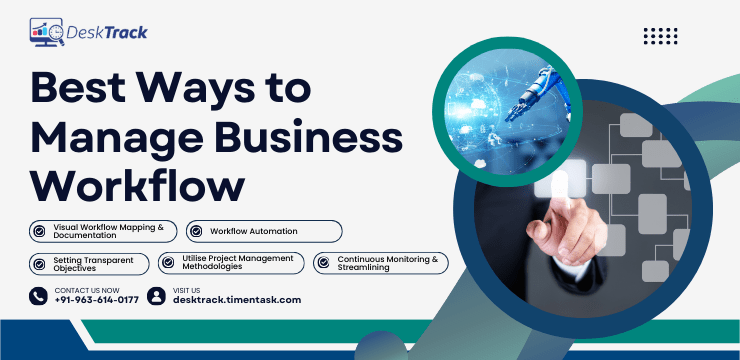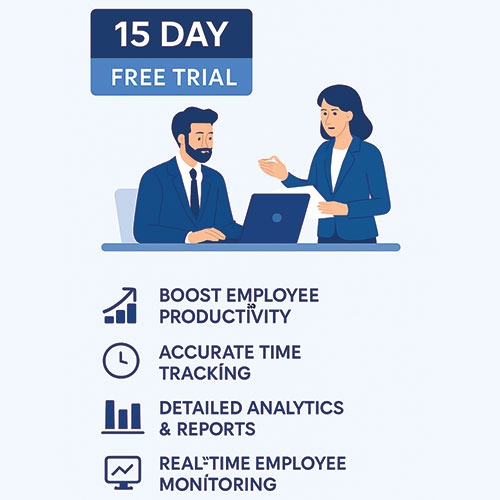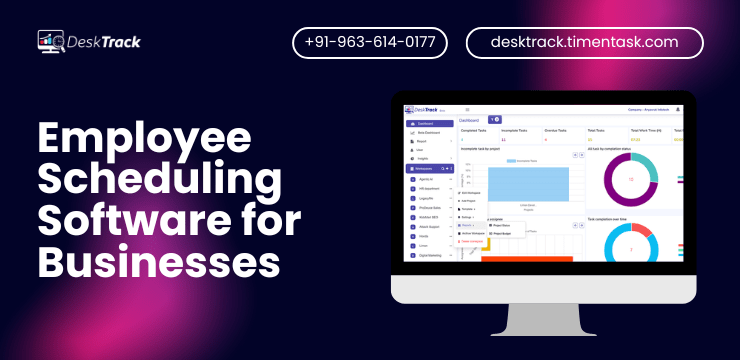
Whether you are looking for the top 5 ways to manage business workflow or want to revise your insights regarding this topic, you are on the right page. Today, I will take you through the most complex aspect of running and managing business projects. That is workflows. You will also get many valuable insights to boost workflow efficiency and simplify project management.
Did you know that efficient business workflow management, especially via automation, can save time by reducing 60-95% of repetitive tasks and enhancing data security by 88%? So now you know how essential it is to understand and manage the project workflow to get immense success.
To start, I will jump straight to the challenges you will face as you manage business workflow. Next, I will cover the 5 workflow methods, and the 7 steps to implement for effective management of your workflow. With that, let me get started right away with it.
10 Common Challenges in Managing Business Workflows

As I mentioned before, managing workflows sounds simple but it is a complicated task when done practically. Overall, to accrue and make your workflows efficient, you will have to first tackle these 10 common challenges.
1. No Visibility
To efficiently manage business workflow, you need to have a 360-degree view of the processes and methods. This way, you can make changes whenever required to ensure that the project is not delayed or stalled for long.
However, that’s where most businesses and organizations fail. Why? Because of the lack of proper employee monitoring software implementation.
2. Obstructions & Delays
Another thing you need to do to efficiently organize workflows is to tackle obstructions and delays. There are many reasons for these issues such as:
- Sudden change requests from client
- Employees taking sick leaves mid-project
- Technical problems such as software bugs and slow internet.
You need to be prepared for these obstructions uncalled for, as these issues can arise at any time. Especially, when you least expect them.
3. Communication Breakdowns
Another obstacle in your way to efficiently manage business workflow is communication breakdowns. Again, there are multiple reasons for this including:
- Multiple communication channels (some employees use emails while others prefer instant messaging, which causes delays and confusion)
- Geographically dispersed teams and employees (multiple locations and time zones)
Read Also: How to Choose the Right Absence Management Software for Your Business?
4. Process Inconsistency
You need to get rid of inconsistent procedures to improve workflow efficiency. However, that’s one of the biggest challenges because of multiple types of projects. So generally, what you will do is use different processes for the same. However, that just adds an extra task to your workload. That is to choose the right methods for the right projects, which is time-consuming.
5. Employee Resistance
I might have mentioned this in my other blogs. However, here’s a reminder. Employees function with the live and let live mindset. So every time you try implementing a new way to manage business workflow, there will be retaliation from employees.
According to my experience and expertise as a manager, these are excuses. However, there are some genuine issues as well. For instance, if you are implementing workflow management software, your employees might raise privacy concerns.
6. No Automation
Many organizations and businesses worldwide still waste time by not implementing workflow software for automation. Processes including manual payroll and tracking staff attendance without utilizing dedicated software take up most of your time, which also incurs unnecessary expenses due to errors and inefficiencies.
7. Decentralized Data & No Integration
You can also maximize the time taken to manage business workflow by storing your data across multiple devices and not integrating all the tools and apps you use. This consumes time as:
- You have to fetch data from multiple locations, finding which can take time.
- As no tools and apps are integrated, you will have to keep multiple apps open, which slows down the devices as well. Again, this also contributes to time wastage while fetching the right data source.
8. Insufficient or No Training
Let me assume that you implemented the workflow software. However, if your employees are not trained to properly use it, then it’s the same as not implementing it. Another issue with untrained or insufficiently trained employees is that they can’t use the right skills for the right tasks, projects, and at the right time. This mismatch again costs you time and money.
9. Performance Management Challenges
To efficiently manage business workflow, you also need to manage the performance of your teams and employees. However, it’s not very simple as:
- There are diverse working models and infrastructures in place.
- Employees and teams are geographically dispersed.
- You have large teams spread out across multiple departments.
Individually tracking the performance of each employee can be a problem. Especially, for businesses and organizations that are not using workflow software.
10. Scalability Issues
Another challenge you must tackle is scalability. That is as your business grows and you start getting more clients and projects, you also need to scale your workflows accordingly. However, all I can say here is that it is again complex and frustrating, especially if you don’t use software for the same.
5 of the Best Ways to Manage Business Workflow

So now you know the challenges to tackle in your way to improve workflow efficiency. The solution to all these problems is to use the top 5 ways to ensure smooth workflows. With that, allow me to explain these as simply as possible.
1. Visual Workflow Mapping & Documentation
Here’s the thing, the more complex the project is, the better it is to visually understand it and manage business workflow and documentation. However, I would not recommend the use of boring plain text. Instead, you must use charts and graphs. Thus, here are a few tips regarding the same.
- To explain processes to my employees, I use flowcharts and process maps for clarity. This technique saves a lot of time, which me and my employees use to do fruitful work.
- The flowcharts and process maps help you quickly identify obstructions and inefficiencies that can occur. This ensures that when you start working on the project, everything goes as planned.
- As I mentioned before, using different processes for multiple projects is time-consuming. Instead, standardize all your processes to save time as all you have to do is change tasks for every new project.
- Another thing I would do to save time and reduce expenses is to use visual workflow mapping tools.
2. Workflow Automation
Did you know that around 50-60% of businesses are using workflow software for automation? Are you? So if you want to automate your workflows, here’s what you should do:
- Understand everything about workflow automation software solutions and choose the right option as per your industry and requirements.
- Repetitive tasks and approvals can cause delays. Well, automate them.
- Another thing related to workflow automation is Integrated tools and apps. A common instance of this is your time tracking software integrated with your payroll tool. What it does is automate payroll processing as employee hours data is directly sent to your payroll software based on your configurations.
3. Setting Transparent Objectives
Another aspect to remember to efficiently manage business workflow is to set transparent goals. Not only do your employees need to have clarity on what to do but:
- Your staff also needs to know who is the process administration and to what extent they can modify the workflow according to their designations and roles.
- Another essentiality is that your employees must also have responsibility and accountability for the tasks assigned to them. The best way to achieve this is via proper communication. Use it, people.
- A tool I use to set transparent goals is the RACI matrices, where RACI expands to responsible, accountable, consulted, and informed. This project management tool helps you clarify team roles and responsibilities across tasks.
- Some projects will also require all or some of your multiple departments to work together. For such a situation, what I would do is implement cross-department training for all my employees and teams.
4. Utilise Project Management Methodologies
Another ingredient for perfectly managing workflows is utilising the various project management methodologies. I recommend flexibly using the lean, agile, or waterfall methods as per the project demands and of course, following these tips.
- Break down projects into manageable tasks. Completing them in the right sequence results in the smooth completion of the project. Also, it becomes easy to delegate work this way.
- It’s also essential to track work progress against the performance metrics to see whether everything is going according to the plan or if you need to make changes.
5. Continuous Monitoring & Streamlining
Continuous monitoring and streamlining are also essential to effectively manage business workflow. The reason behind it is that uncertainties are a part of the project. So you need to be prepared for them with continuous workflow tracking so that you can make necessary changes as and when required. Here’s what I usually do.
- Collect and evaluate the data from my software solution for workflows and KPIs tracking.
- This helps me identify any room for improvement.
- I also take continuous feedback from my employees and managers to make iterative changes as per my needs.
Read Also: Top 10 Employee Timesheet Software for 2025
6 Steps to Effectively Manage Business Workflow
Make your workday more productive
Time tracking and work management can help you reach your goals
faster.
So now you must have clearly understood the top 5 methods of managing workflows. However, wait, there’s more. Overall, implementing these 6 steps in your processes makes your workflows efficient and more fruitful. With that, let me get right into it.
1. Automate Repetitive Tasks
Creating and managing business workflow in itself is a repetitive task. Other such tasks include manual work-hour entries, email sorting, answering the same or similar customer queries, and generating reports.
These tasks consume most of your valuable time, which can also incur costs due to inaccuracies and inefficiencies. However, as big as the problem is, the solution is very simple. All you have to do is use artificially intelligent applications and tools to automate this work.
2. Optimise Communication
Another simple technique to improve workflow efficiency is to streamline communication. Remember that your employees are not psychics or mind readers. So there is no way for them to know how you want them to work without you telling them in the first place. So to relay information to my employees with clarity I use multiple methods as per the requirements including:
- Quick and short meetings to explain the workflow. I recommend keeping this weekly or monthly.
- Directly tell my employees what to do and how to do it.
- Use a common communication channel that also notifies my employees.
- Inspire my employees to directly talk to each other when it comes to relaying crucial information.
3. Set Clear Deadlines & Goals
Before you can manage business workflow, you also need to ensure that there is no confusion or misunderstanding between you and your employees regarding tasks, projects, etc. Your employees must have complete clarity over what they have to do and how they have to do it.
Otherwise, there will be no teamwork and work synchronization. Plus, there is a high chance that you will get the wrong output, meaning that all the efforts would go to waste as you would have to restart.
4. Utilize Project & Task Management Software
The best way to club all these complex workflow methods and simplify processes is to use the right task and project management software solution as per your unique business requirements. The software will also provide you with additional useful features such as:
- The capability to create unlimited projects, tasks, subtasks, and checklists and assign them to employees and teams.
- Real-time project progress and task time tracking.
5. Standardize Processes
A proven expert technique I use and recommend to effectively manage and organize workflows is to standardise procedures and processes. As I mentioned before (or didn’t), the idea here for you is to have consistency in processes, which saves time as all you are doing is changing the tasks for each new project. Furthermore, according to my expertise and experience, sometimes, the tasks are also the same for similar projects. That even saves more of your time.
6. Utilise Workflow Management Software
The last and most essential step is to use workflow automation and management software. Using such solutions:
- Saves you time as you can drag and drop to create workflows.
- Provides you with more accuracy.
- Automates repetitive tasks
- Provides you with editable workflow templates, which help a lot when you have less time to set up custom workflows.
Do More Than Just Streamline Workflows with DeskTrack

I will be honest with you here. DeskTrack is the best software to streamline workflows. Not only that, this integrated project management, productivity monitoring, employee monitoring, and time tracking software solution also provides you with many other features and functionalities to maintain work integrity like:
- Screenshot monitoring for workflow management and insider threat prevention.
- Real-time online and offline app, URL, and file tracking.
- Call and location tracking (mobile app).
- Seamless integrations with all the other tools and applications you use.
- Multiple project views including the colour-coded calendar view.
Properly utilizing these features maximize employee productivity and the overall profitability of your organization.
Conclusion
I hope you are clear about the top 5 ways to manage business workflow. As a final word, I can say that workflows are the most complex aspects of running projects and businesses. If you efficiently manage this, then everything else will seem simple. However, to achieve success at the initial step, which is workflow management, is necessary. You need to be prepared for uncertainties and use only the best tools and techniques to get the expected results. With DeskTrack, which is the best all-in-one employee monitoring software, you can streamline workflows and do more to maintain work integrity, increase employee productivity, and the overall profitability of your organization.
Frequently Asked Questions (FAQ)
Q. How Many Types of Workflows Are There?
Ans. As business professionals, you and I have to manage these 4 workflow categories.
- Sequential
- State Machine
- Rules-Driven
- Collaborative
Q. What are the Workflow Management Challenges Organizations Face?
Ans. Businesses and organizations worldwide face many workflow management challenges like:
- No Visibility
- Obstructions & Delays
- Communication Breakdowns
- Process Inconsistency
- Employee Resistance
- No Automation
- Decentralized Data & No Integration
- Insufficient or No Training
- Performance Management Challenges
- Scalability Issues
Q. What are the Top Ways to Manage Business Workflow?
Ans. I have shortlisted 5 of the best ways to manage and simplify even the most complex business workflows.
- Visual Workflow Mapping & Documentation
- Workflow Automation
- Setting Transparent Objectives
- Utilise Project Management Methodologies
- Continuous Monitoring & Streamlining
Q. What are the Steps to Effectively Manage Business Workflow?
Ans. Below I have covered 6 steps for effective workflow management for your business.
- Automate Repetitive Tasks
- Optimise Communication
- Set Clear Deadlines & Goals
- Utilize Project & Task Management Software
- Standardize Processes
- Utilise Workflow Management Software
Q. Which is the Best Software to Streamline Workflow?
Ans. DeskTrack is the best software to streamline the workflows of your business. Plus, it also provides you with other features and functionalities to maintain work integrity and boost productivity and profitability including:
- Screenshot monitoring for workflow management and insider threat prevention.
- Real-time online and offline app, URL, and file tracking.
- Call and location tracking (mobile app).
- Seamless integrations with all the other tools and applications you use.
- Multiple project views including the colour-coded calendar view.





